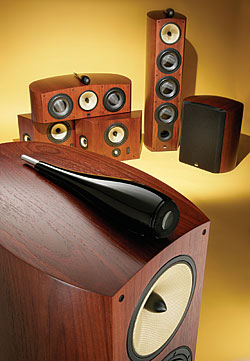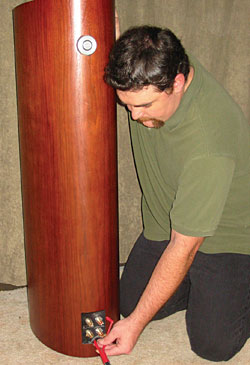B&W 803D Speaker System
If truth be told, I have little use for diamonds in their conventional form. This probably stems from all the pomp and pageantry that surrounds them—not to mention my disdain for those people who drape themselves in the stones and attempt to outshine everyone else with their brilliance. This hardly means that I have little respect for diamonds, though, even if this respect is far more about material than materialism. Since ancient times, mankind has recognized the value of the diamond for pragmatic applications, in everything from grinding and engraving tools, to drill bits, to turntable styli and semiconductors.
 B&W has a long history of putting various materials to excellent use, so it should come as no surprise that they are breaking ground in adding tweeters to the long list of items that benefit from diamond construction. Their goal with the diamond tweeters that adorn several models in their high-end 800 Series is to continue to push the breakup frequency—the point at which the driver no longer operates as a piston and begins to introduce major colorations—higher and higher. Studies show that diamond's first breakup frequency in this application is as high as 80.8 kilohertz—roughly three times that of aluminum. Granted, human hearing tops out at around 20 kHz, but there is substantial evidence to show that the range we do hear is powerfully affected by what's going on in the range we don't hear. The emergence of high-resolution audio has only increased the need for tweeters that can hold form at higher frequencies.
B&W has a long history of putting various materials to excellent use, so it should come as no surprise that they are breaking ground in adding tweeters to the long list of items that benefit from diamond construction. Their goal with the diamond tweeters that adorn several models in their high-end 800 Series is to continue to push the breakup frequency—the point at which the driver no longer operates as a piston and begins to introduce major colorations—higher and higher. Studies show that diamond's first breakup frequency in this application is as high as 80.8 kilohertz—roughly three times that of aluminum. Granted, human hearing tops out at around 20 kHz, but there is substantial evidence to show that the range we do hear is powerfully affected by what's going on in the range we don't hear. The emergence of high-resolution audio has only increased the need for tweeters that can hold form at higher frequencies.
The 800 Series isn't all about diamond tweeters, though. These models also benefit from B&W's FST midrange driver, a Kevlar construction that is very successful at blending stiffness and rigidity with a high inherent damping factor. There's also the Rohacell bass driver, which sandwiches an 8-millimeter piece of polymethacrylimide (i.e., hard-foam) material between two layers of carbon fiber for a beneficial blend of weight and mechanical properties with heat resistance. And, of course, there's the famous B&W cabinets, usually topped off by the distinctive, separate tweeter (and, occasionally, separate midrange) housing. This design does have important practical purposes, such as reducing cabinet diffraction and time smearing, in addition to giving many B&W speakers their unique look.
My review system was anchored by the new 803D tower, a model that is three short steps down from the top of the 800 Series. It uses a 1-inch diamond dome tweeter, a 6-inch FST midrange unit, and three 7-inch Rohacell bass drivers in a three-way, vented-box system with a front-firing port. Extensive bracing and driver isolation are just some of these speaker cabinets' internal perks, and the new external design is as acoustically beneficial as it is attractive. Two pairs of top-quality binding posts allow for biwiring/biamping.
Manning the center was the HTM2D, which uses the same tweeter and midrange drivers as the 803D, flanked by two of the same 7-inch woofers. This is also a vented, three-way design, although it uses two rear-firing ports. This cabinet is impressive in its internal and external design, as well, and it's magnetically shielded for placement near a CRT-based video monitor. Two pairs of binding posts make this unit biwireable/ biampable, too.
Two DS8S speakers handled the surround channels. The DS8S is a switchable monopole/dipole design that uses a 7-inch Kevlar midbass driver mounted above a 1-inch aluminum dome tweeter on the front baffle. A 4-inch Kevlar midrange is mounted above a 1-inch aluminum tweeter on each of the side baffles. It's a two-way system when it acts as a monopole. In its dipole mode, it's a three-way system; the front tweeter turns off, and the front driver acts as the woofer. Keyhole mounts on the DS8S's rear panel make for easy wall mounting.
Rounding out my system was the ASW825 subwoofer, a sealed design that uses a 12-inch Rohacell woofer and no less than 1,000 rated watts of amplification. Thanks in part to its use of switched-mode power supplies, it remains relatively small and light despite its impressive internal power. The rear panel offers line-level inputs and outputs, phase, gain, and crossover controls, and crossover bypass.
Top-shelf speakers need top-shelf electronics, so I set up the B&W system with a variety of amplifiers, including a Lexicon LX-7, a Simaudio MOON Titan, and even my old Aragon Palladium monoblocks. A Lexicon MC-12 served as the primary pre/pro, and the Simaudio MOON Orbiter universal player spun the source material. I set the front speakers a couple of feet from the side and rear walls and toed them in slightly; I mounted the center channel near ear level below a projection screen; and I placed the surround channels 120 degrees from the listening position, about 1 foot above ear level in the seated position.
Right out of the gate, with two-channel music, the 803Ds grabbed me with a deep, wide soundstage and excellent imaging. Vocals that were recorded to be in the dead center were reproduced in the dead center. If they were meant to be off to one side or the other, they were. Guitars, drums, harmonicas, banjos—you name it, and the 803Ds will place it right where the musicians and, ultimately, the engineers intended it to be placed. One of the most impressive displays of staging was with "Katy Hill" from the CD The Three Pickers, a track that captures some 25 instruments on stage at the same time, including multiple guitars, fiddles, and banjos. Having seen the DVD rendition of this concert many times, I know exactly where everyone is supposed to be, and that's right where they were when I listened to the CD through the 803Ds. The speakers also did a fantastic job of separating each individual fiddle, guitar, or banjo, even if they were playing the same part.
 I suspect many of you want to know if the diamond tweeter lives up to its hype in the listening room. It does, indeed. Anyone concerned about diamond's potential for considerable mass will find no evidence of it here. This tweeter is as agile and pure-sounding as any I've ever heard, no matter what material I gave it. Cymbals were crisp and clean, with no sibilance or overhang. Benny Goodman's clarinet was as natural as the recording would allow it to be. And Little Walter's harmonica had an attack and immediacy that can only have been just short of hearing it live.
I suspect many of you want to know if the diamond tweeter lives up to its hype in the listening room. It does, indeed. Anyone concerned about diamond's potential for considerable mass will find no evidence of it here. This tweeter is as agile and pure-sounding as any I've ever heard, no matter what material I gave it. Cymbals were crisp and clean, with no sibilance or overhang. Benny Goodman's clarinet was as natural as the recording would allow it to be. And Little Walter's harmonica had an attack and immediacy that can only have been just short of hearing it live.
The B&W system saved its most impressive musical output for high-resolution material, though. It was here that, with properly engineered material, the speakers absolutely disappeared, and all that was left was music in a natural and effortless state. I could ramble on about how impressively the system reproduced each individual frequency range, but the ultimate goal of each speaker is to operate as its own subsystem, reproducing the entire spectrum (or at least as much of it as it's designed to) successfully and without holes. I already knew the 803Ds could do this, but I quickly learned that the HTM2D, and even the DS8Ss, could too, and this made for an unforgettable 5.1-channel musical experience. This material didn't tax the ASW825 much, but the sub made the most of its opportunity and proved that movies aren't the only thing it's comfortable with.
Speaking of movies, the disappearing act continued with soundtrack reproduction—and that made for an intense and electrifying experience with scenes like the Omaha Beach assault from Saving Private Ryan or Gandalf's fiery descent with the Balrog from LOTR: The Two Towers. I found myself entirely caught up in the experiences, and, at times, I forgot my critical role and simply reveled in running my all-time-favorite movie scenes through this system for pure enjoyment. I kept my head about me enough to note that all the critical soundtrack elements were here: clean, uncluttered dialogue, an entirely cohesive and deep surround soundfield, and forceful, penetrating bass that only overwhelmed when it was supposed to. The HTM2 is as strong a center channel as you'll find anywhere. It relishes in the challenges that modern soundtracks present to this channel and simply refuses to be overwhelmed. Its effortlessness is one of its most endearing qualities—and I could say the same about this system as a whole. If you can't get lost in this system and forget you're listening to speakers, there may be no hope left for you.
I fully admit to having considerably high expectations when I see the B&W logo on the front of a speaker. All the talk about the diamond tweeter that I had heard prior to this review, along with what I already know about B&W's midranges, woofers, and cabinets, only increased my expectations. This system not only met those expectations; it exceeded them—and memorably so, at that. These speakers are a prime example of the successful manifestation of build and design principle into sonic reality in the listening room. But the pure enjoyment and excitement that this system delivered is probably the ultimate compliment I can pay it. This B&W system was as enveloping, exhilarating, and flat-out enjoyable as any speaker system I've ever heard.
Highlights
• World-class sound with music and movies
• Pure enjoyment and excitement factor





























































